run14UPCtriggerdevelopement
24-APR-2014
analysis of the AuAu_200_production_low_2014 runs of day 100:
Production low /star/data05/scratch/ramdebbe/2410119D2C9007518A40462F787F7EED_*.tree.root /data09/
/star/data05/scratch/ramdebbe/97D03129DA23A13A0A4AAB420B8CA9EF_*.tree.root /data10/
/star/data05/scratch/ramdebbe/E01FB7B27713401EFF33D03FB1ECD1A5_*.tree.root /data11/
/star/data05/scratch/ramdebbe/8FEE72702A29B60EFF6DCAB061ED7220_*.tree.root /data12/
The prescales for these runs range from 6.7 in the early runs to 1 at the end of the day. I use an average of 4 in what follows.
Number of events: 197947
Number of UPC_Main triggers: 197947
Number of UPC_Main-p triggers: 52781
the effect of the "past protection" at these low luminosity runs is small: 0.94 (this ratio is defined as #UPC_Main*(average prescale)/#UPC_Main-p and it is consistent to 1)
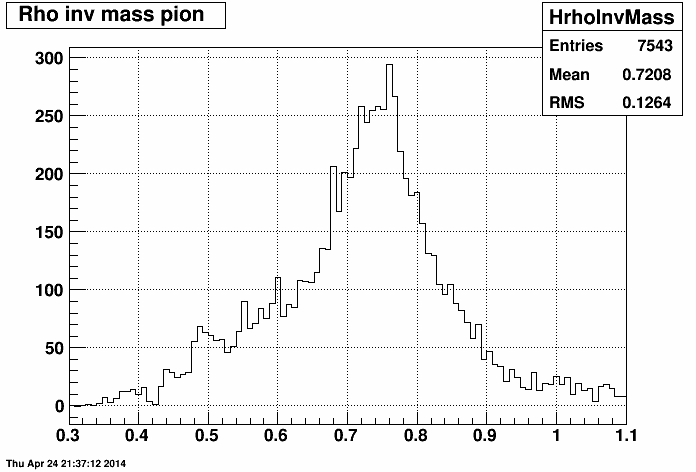

Again, these histograms are filled with loose rho candidates (same conditions on both histograms, but these are not the final two track vertex events). The same charge background has been subtracted, others can do a more detailed analysis.
The same "purity" we extracted from the "production_high" runs have the following values:
UPC_Main (unprotected) : 7543/197947 = 0.038 UPC_Main-p (protected): 2913/52781 = 0.055
The "improvement" in purity at these low luminosity runs is now lower: 45% compared to the 60% seen at high luminosity
I also processed the AuAu_200_production_mid_2014 runs (there are only 3 of them)
the output trees are:
Production mid /star/data05/scratch/ramdebbe/9D481ECCC73329D7D35C7C22933428AF_*.tree.root /data09/
/star/data05/scratch/ramdebbe/6212BF0D47DD893F9B6CD82DD952EA38_*.tree.root /data10/
/star/data05/scratch/ramdebbe/0E882367D97AB60CA52F925E9B4E433E_*.tree.root /data11/
/star/data05/scratch/ramdebbe/A1636A9A5294616B6EEA759E4C945C4E_*.tree.root /data12/
The prescales for these 3 runs range from 6.7 are 8.4, 7.5, 6.9 respectively. I use an average of 7.6 to calculate the expected number of protected triggers.
Number of events: 50266
Number of UPC_Main triggers: 50266
Number of UPC_Main-p triggers: 3441
The number of expected "protected" triggers being 6613 the actual effect of the protection is a reduction by a factor of 1.92
The number of entries in the "rho candidate" histograms is so low that it makes no sense to use such loose numbers in the "production_mid" case, but I show the unprotected case for the sake of the argument:

++++++++++++++++++++++++++++++++++++++++++++++++++++++++++++++++++++++++++++++++++++++++++++++++
20-APR-2014 (after a flurry of emails in the upc list, a correction is needed)
the analysis I presented last night made a wrong assumption that because the protected and unprotected triggers have the same value of scale-down its effect was applied to both triggers at the same event level.
In reality things do not work that way, scale-downs reject events randomly. The events written on the trees listed below are all UPC_Main triggered, if I look for UPC_Main-p among them my expectation should be
N/PS
We have requested the fast offline production for the st_upc stream collected on day 100 in all three production modes.
The first item of interest in this production is the comparison of the protected (UPC_Main-p) and unprotected (UPC_Main) versions of the UPC_Main trigger.
UPC trees were produced for the AuAu_200_production_high_2014 trigger setup. The outputs and log files are to be found in the scratch area of data05:
Production high /star/data05/scratch/ramdebbe/0F9042BEDEEDB1A3592FDCBEF5021CF5_*.tree.root /data09/
/star/data05/scratch/ramdebbe/E2DD241ECC9E8739D18C1F59EDA83DF1_*.tree.root /data10/
/star/data05/scratch/ramdebbe/E1B71EA43C4231F431D31EA16DF430B1_*.tree.root /data11/
/star/data05/scratch/ramdebbe/92FE7DD6893E129D42DBEFB2BC23E168_*.tree.root /data12/
The uncorrected zdc coincidence rate has been added to the trigger branch of these trees. The name of the variable is zdcCoincidenceRate
A pass through that data has produced the following quantities.
Number of events: 328258
Number of UPC_Main triggers: 328258
Number of UPC_Main-p triggers: 16080
In average, all through day 100 both triggers had identical scale-downs that range from 8 to 12. The expected number of UPC_Main-p is 32826, there is thus a factor of 2.02 reduction due to the "past-protection" added to the UPC_Main-p trigger.
While we process these trees we kept track of which triggers fired and filled some histograms for the triggers of interest. In this first pass, the first trigger (recorded in the trg_3000 leaf) is UPC_Main. The second
trigger of interest id UPC_Main-p (recorded in trg_2001)
Rho mesons were reconstructed for both UPC_Main types of triggers as well as their respective backgrounds:

.png)
After subtraction of the background the number of events in the resulting histograms (no further cuts) is:
UPC_Main: 4843 events
UPC_Main-p: 385
Scaling back the UPC_Main-p counts by the factor of 2.02 gives us 828 events while the expected number was 484; is an increase of 71% compared to UPC_Main
Assuming an average scale-down of 10 (ps1=ps2=10) and the "cost" of protection: fact2 = 2.02, the corrected numbers in the runs analyzed are:
UPC_Main-p: 410*fact2*ps2*ps1
UPC_Main : 4843*ps1
ratio protected/unprot = 410*fact*ps2/4843 = 1.71
A better comparison would be to calculate the number of rho mesons found per event:
UPC_Main-p : 385/16080 = 0.024
UPC_Main : 4843/328258 = 0.015
a factor of 60% increase for the protected trigger
++++++++++++++++++++++++++++++++++++++++++++++++++++++++++++++++++++++++++++++++++++++++++++++++++++++++++++
1-APR-2014
We have requested the processing of all st_upc files for runs collected on day 80
Some of the jobs are finished and some MuDst are available in disks /star/data09/ 10, 11, and 12
The first trigger to be processed is:
UPC_jpsiB with UPC trees in /star/data05/scratch/ramdebbe/064E8633364381A6F533A4553820B9E8_*.tree.root /data09/ as of 16:00
/star/data05/scratch/ramdebbe/B13E303B66F0EFF0C5B8A5A9759BFDA4__*.tree.root /data10/ as of 21:40
/star/data05/scratch/desilva/upcFastOffline/dataFiles/15B9C25A3BA22B1A4513483DAC73529E_*.tree.root /data11/ as of 1-APR 23:40
Looking at this set of 32K events we can see that the trigger appears to be enhancing the electron content in those events. The figure below shows the 3378 tracks identified as electrons by their ionization energy loss in the TPC gas volume.
.png)
Now that we have processed most of the evnts, I am not so convinced of an actual electron enhancement. The electrons are identified using the "probability" value with a cut as low as 0.2
With the new statistics one can see the contamination from kaons (blue) and protons (green) and the high momentum "electrons could well be pions.
The red markers show the tracks identified as electron. What is new in this plot is the number of electrons present above 500 MeV in such a small sample.
The correlation between cluster energy in the Barrel and the momentum of the track extrapolated to the calorimeter shown below is obtained with stringent cuts in eta and phi differences between the cluster coordinates and those of the intercept of track and calorimeter active volume.

The invariant mass of electron pairs (identified by dE/dx in the TPC is mostly peaked at values below 1 GeV:
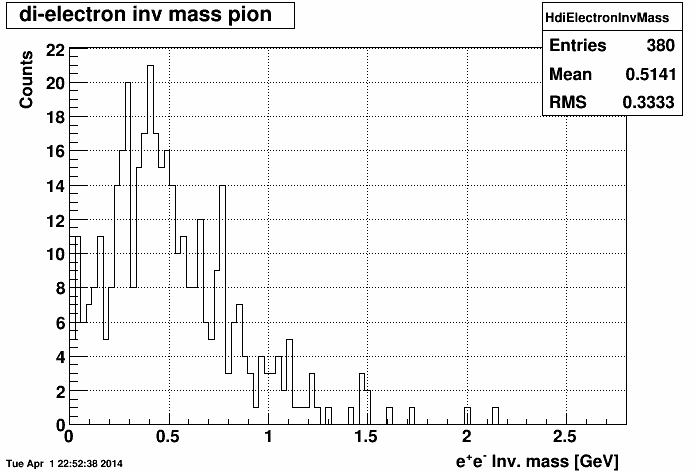
and finally, the transverse momentum distribution of the electron pairs does not show a clean signal for coherent production.
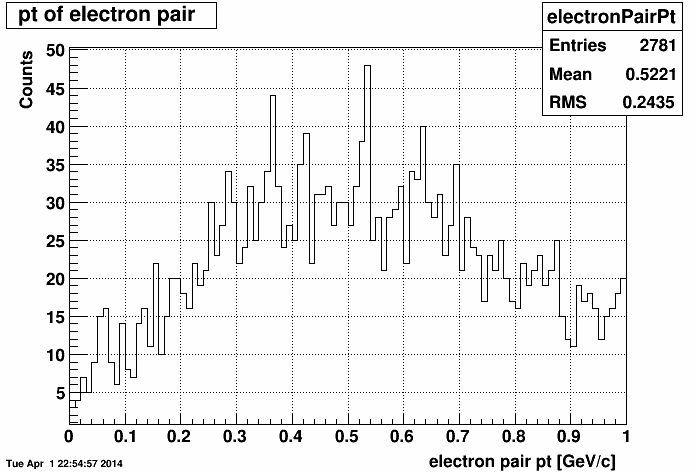
For what it is worth I add a figure of invariant mass in the J/Psi region because we have one count (a bit high mass)

With more data we may see this "grass" grow
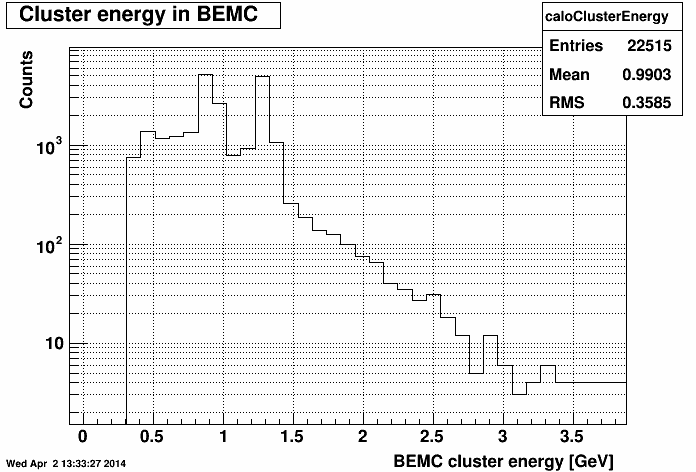
The actual signal in the calorimeter added into clusters. Possibly the trigger signal stands as two peaks below 1 and 1.5 GeV respectively. Is the difference in energy due to the fact that one arm of the trigger fires on a "high tower" and the other on a "jet patch"?
===================================================================
25-MAR-2014
Many thanks to Eleanor for her work on the algorithm that defines the UPC_highG. In typical Berkely parlance I would say "That puppy is cooking!!"
Fast-offline production has been done on runs 15077069, 70 and 79 (this are the runs just after all six UPC trigger were introduced) I have processed the MuDst and produced UPC tree that are now available in data05 scratch disk:
UPC_topo was selected as "trigger of interest" and the output is in /star/data05/scratch/ramdebbe/7C7F7581B1F79E8E617A7CCB51AE99BF_*.tree.root and
/star/data05/scratch/ramdebbe/DC448ABFE7B2C1128380474BD2093E74_*.tree.root
UPC_jpsiA /star/data05/scratch/ramdebbe/1676EA04EFEF5DFE057B16587E39FF1F_*.tree.root (15077069) (checked 27MAR)
UPC_jpsiB /star/data05/scratch/ramdebbe/E9D941CA4EE5219D024AFE80A9901A73_*.tree.root (15077069) (checked 27MAR)
/star/data05/scratch/ramdebbe/EA8A44BDDFA612221856FDBABA3DBB0E_*.tree.root 15077070 79 and 15079025) (checked 27MAR)
UPC_jpsiC /star/data05/scratch/ramdebbe/133CA34484641A9FD61908E6BF8C8B74_*.tree.root (15077069) (checked 27MAR)
UPC_Main /star/data05/scratch/ramdebbe/27920652D85DCD26339B373A38A36816_*.tree.root (15077069) (OK)
/star/data05/scratch/ramdebbe/EB8EE089E92E784AFE1857F9E86506E7_*.tree.root (15077070 79 15079025) (checked 27MAR)
UPC_highG has output in /star/data05/scratch/ramdebbe/FAD3FCA1014AF3E2CBCF539C077B5104_*.tree.root (15079025)
The UPC_Main sample shows decent signal for rho meson detection:
.png)
and the coherent component is clear (red histogram is same charge "background")
.png)
We can also see the rho meson in the UPC_topo sample:


The distribution of pion pair transverse momentum is an confirmation of a clean coherent interaction of the rho mesons with the Au target.
The UPC-topo has thus being elevated to physics as run 15084036 is collecting data. This trigger has been operational since the day it was added to daq (15077069).
The UPC_highG is doing even better!!

and a wonderfull coherent peak:
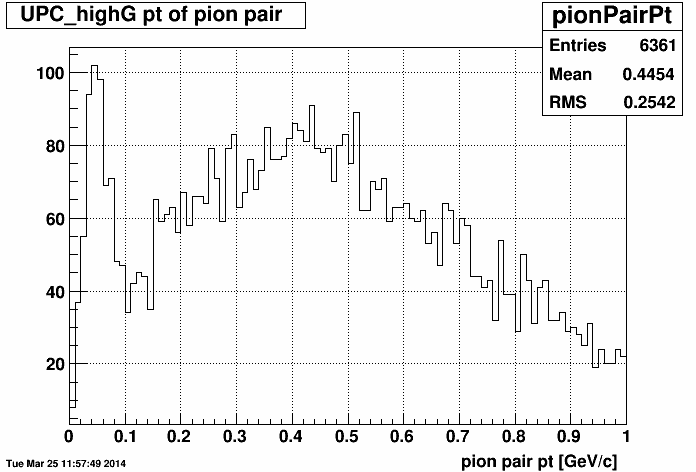
the difference in TOF tray number:

=======================================================================================
21-MAR-2014
The trigger files from run15078004 are still on disk. We can thus look at the calorimeter while our 3 JPsi triggers were in operation:

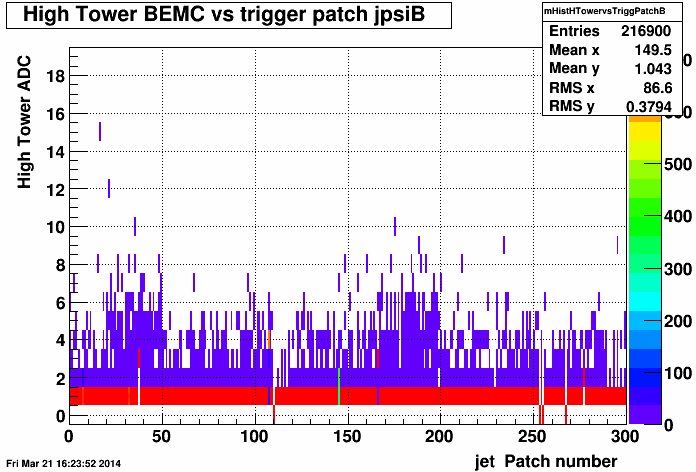
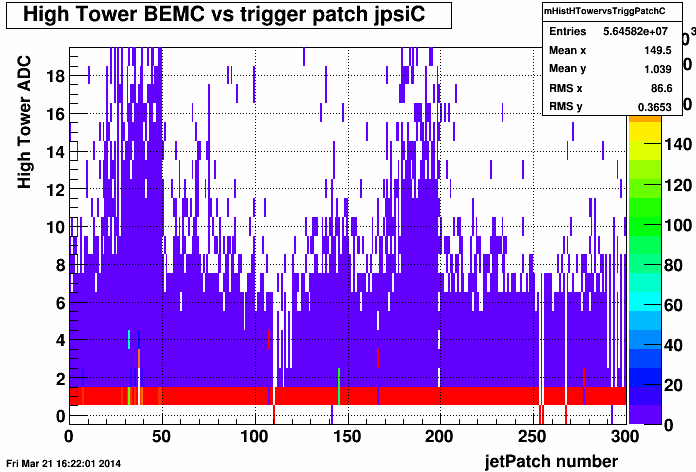
All three triggers are firing below JP 50 and 200, is that the location selected by our triggers (they have the same BEMC trigger logic). But the signal in A and C appears to be too big for 1.5 GeV/c electron showers? Besides that, reading Eleanor's description of the HT.TP algorithm I would expect a more niform distribution in jet patch number.
20-MAR-2014
run 15079022:
UPC_jpsiB:
First look at the activity in the BEMC calorimeter: High Towers versus trigger patch number:

Eleanor found that the definition of UPC_highG was wrong and we changed the TOF_UPC bit from being a veto to "on" The scale down was also changed and the final rate was set to 20Hz a snap shot of trigger rates can be seen below:

and the distribution of active trays as well as the tray difference appears more reasonable:


As well as the multiplicity of TOF hits:

Comparable to similar distribution produced with UPC_topo triggers.
==================================================================
run15077069 70 and 79
This evening all six of our UPC triggers were included in the ongoing "AuAu_200_production_2014" setup for the trigger.
A first look at these data is possible by reading the so called trigger files.
From the actual data taking the rates are high in the UPC_highG and UPC_topo triggers:
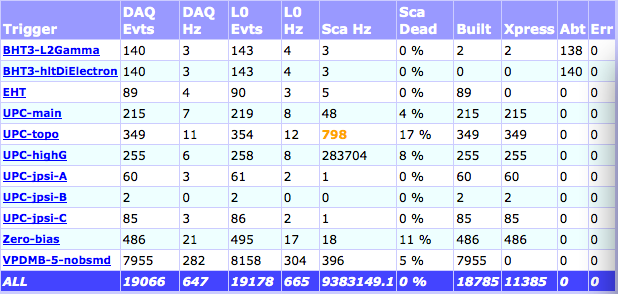
All triggers were set to read at ~10Hz, the necessary prescales are:
UPC_Main 5.6
UPC_topo 56.7
UPC_highG 30K
UPC_jpsiA 1.0
UPC_jpsiB 1.0
UPC_jpsiC 1.0
The actual definitions of the UPC_Main, topo and highG (highGranularity) are shown below:
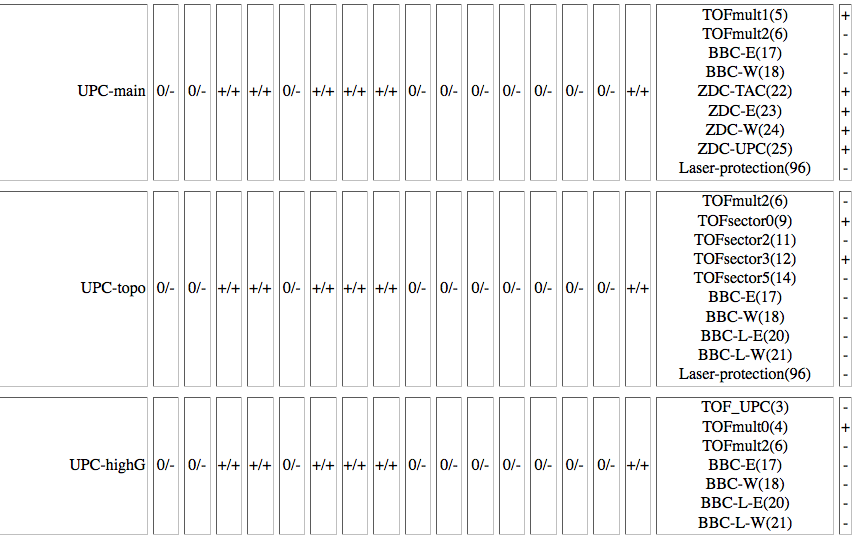
An the definition of the J/Psi developement triggers UPC_jpsiA B and C are shown below:
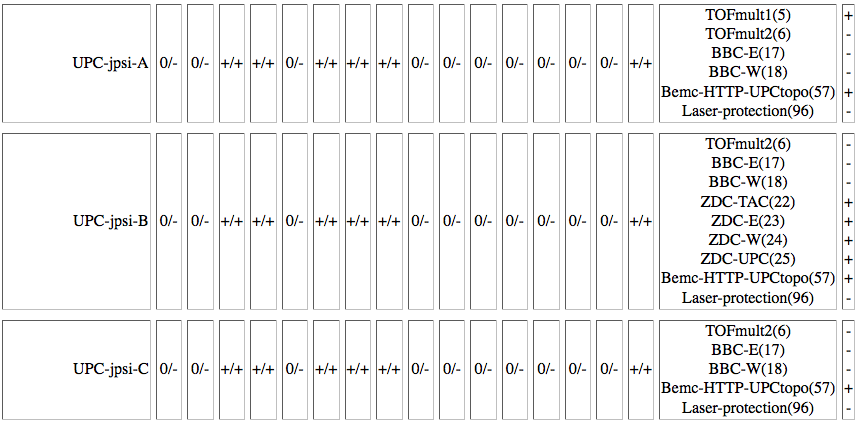
The first results coming from reading run 15077069 are shown next:
The unattenuated ADCs from East and West ZDC have their gains reduced by scaling by 2 in the new trigger module. We will correct for that scaling to get back to our previous settings (1n at ~190 ADC channels)
UPC_Main:

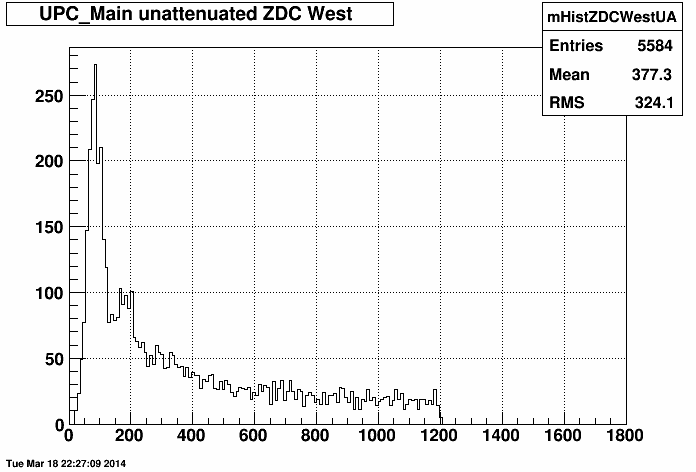
The multiplicity of trigger TOF hits is good:

This trigger appears to be ready to be elevated to physics
UPC_topo:
The distribution of TOF trays in UPC_topo looks at it should due to its simple definition:

In events which have only two trays with hits the difference of tray number (a proxy for azimuthal angle differences) forms two peaks that during the cosmic ray runs and the low energy Au Au collisions were interpreted as back-to back events that remain in one TPC side (East or West) peaking at 30 for very small pt of the pair. The second peak centered at 70 may be related to tracks that move in different sides of the TPC (across the membrane). The right plot below shows similar distribution obtained from actual rho meson candidates from run 10.


The number of trigger TOF hits in the UPC_topo events looks fine:

We need to reconstruct these data and see if we can find rho mesons, once that is done we elevate this trigger to physics.
UPC_highG:
For the UPC_highG we have started with both East and West masks set to 4095 which activates all 24 sectors:

the vertical combination of back-to-back trays appears to be excluded. There are fewer events with just two trays with hits and the distribution of tray Id differences looks way off from what we expect:
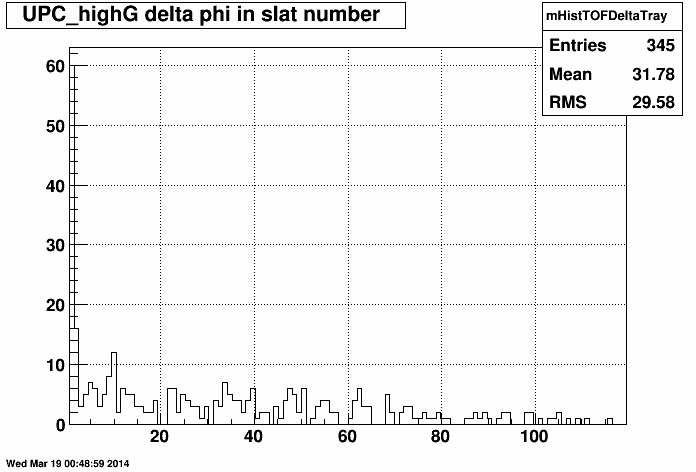
The TOF hit multiplicity is peaking at one hit! Something is amiss.
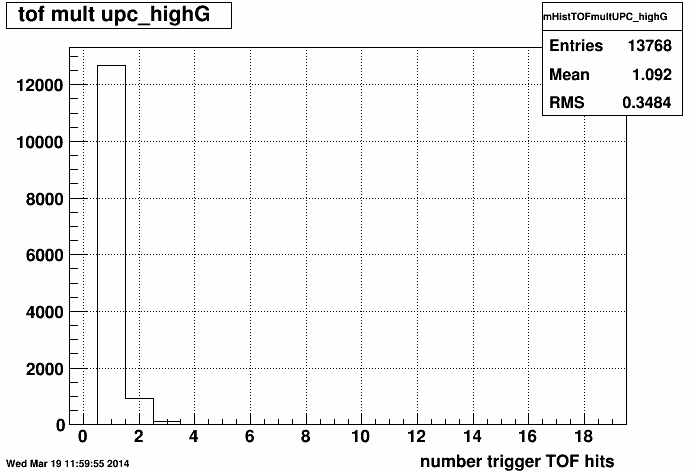
This trigger doesn't appear to be operational. I will change the masks from 4095 (all sectors included) to something more restrictive and the continue its developement.
UPC_jpsiA:
UPC_jpsiB:
UPC_jpsiC:
To look for activity in the events fired by this trigger we look at TOF trigger multiplicity:

This indicates some problem with this trigger.
More results will be available as I learn how to extract the BEMC information that fired the HT or TP elements of the trigger.
- ramdebbe's blog
- Login or register to post comments
